ABSTRACT
Scrap metals can create jobs. It can also be reused and recycled as resource recovery measure in a circular economic model for Ghana. This case study therefore is a preliminary assessment of the quantity and economic value of scrap metals as essential part of resource recovery in the circular economic model. The findings of the study shows that scrap metal industry is growing in the Sunyani Municipality and similar trend is likely in other cities in Ghana as well. The most abundant of the metals found was aluminum while copper was most expensive. Though sales of the scrap was profitable, it was done on monthly basis owing to low rate of volume of scrap realized by the owners. Much of the scrap was dumped at various waste dumping sites in the municipality, thus raising concerns about lack of knowledge of residents about the profitability and recovery values of scrap metals in the circular models. As a result, this could lead to environmental pollution, inefficient resource utilization and energy uses. Therefore, proper education, policy and regulatory measures are key recommendations to prevent these and encourage uses of scrap metals in the circular economy of Ghana. Also, it is recommended that transfer, recycling and foundry stations should be built to prevent high transportation cost due to long haulage distance to final destination points of sales and recycling or reuses.
Key words: Scrap metals, job creation, resource recovery, reuse, recycle, circular economy.
Circular economy (CE) deals with the cyclical nature of Earth and acknowledges the interconnectedness of economy and environment (Bechtel et al., 2013). Current human activities have led to significant use of raw materials and creation of huge amount of waste. This has a significant impact on biodiversity and ecology. This linear industrial model of ‘use and dump’ is unsustainable and therefore there is the need for a new model that uses less raw or virgin material, generates zero waste and is thus more aligned with the cyclical nature of Earth (Bechtel et al., 2013). Therefore, Circular economy has been argued as the way forward for modern economies if environmental degradation is going to stop and much economic effectiveness and efficiency is going to be promoted (Jeswiet and Hauschild, 2005; Meier et al., 2010; Andrews, 2013; European Commission, 2014; Holmström et al., 2014). This is because it is becoming more difficult for developing economies to create value in the midst of volatile and diminishing natural resources and environmental degradation concerns (Accenture, 2014).
As three billion middle-class consumers are expected to enter the global market by 2030, this has driven high demand for goods and services. Commodity prices overall rose by almost 150% from
2002 to 2010 (Waughray, 2014), prompting the need for serious thinking about the continuous use of raw materials. This implies that there is the need to take advantage of circular economy that encourages innovative mechanisms such as resource recovery, recycling and reuses to decouple economic growth from scarce and expensive resources. Scrap metal recovery is therefore very important contributory factor in building circular economy in the developing countries. For scrap metals to have any economic advantage, they should be able to play a key role in one or all of the following four models within circular economy (Accenture, 2014):
1. Lasting resources that can be continuously regenerated over time to not only last longer (efficiency) but last forever (effectiveness)
2. Liquid markets where products and assets are optimally utilized by becoming easily accessible and convertible between users (for example, sharing or trading idle product and asset)
3. Long life cycles where products are made to last in terms of upgrade, reuse and remanufacturing
4. Linked value chains where zero waste is generated from production to disposal by boosting recycling and resource efficiency.
The objective of this research is therefore to preliminarily ascertain the quantity and value of scrap metals in Sunyani municipality for the promotion of circular economic model in Ghana leading to effective and efficient resource mobilization and utilization.
The methodology of this research includes the description of the research design approach, the sampling design and data collection and management to meet the objective of the study.
Research design
Due to the nature of the units of analysis, the design of the study was based on both quantitative and qualitative strategies. Through review of literature on circular economic models for resource recovery and reuse, a gap in knowledge pinpointed the need to research on the possibility of scrap metals as vital component of circular economy in Ghana. Based on this, the objective of the study was to obtain the necessary information regarding scrap metal management in the Sunyani municipality as a case study in Ghana. Sunyani Municipality was chosen because it is fast growing in terms of population and industry. The manufacturing sector forms significant part of the economy, although agriculture is the mainstay (Amponsah, 2011). It is also the seat of the Ghana renowned University for Energy and Natural Resources mandated by the government to seek solutions to the energy problems and wise use of natural resources in the country.
Sampling design
The idea of reviewing the scrap metal management in Sunyani Municipal is to locate scrap sites, scrap owners and the sources from which the scraps are generated. The general sampling design was to classify and collect data from the stakeholders in scrap management industry in Sunyani Municipality.
Sample size
Sunyani municipality is relatively small, therefore trips were made throughout the municipality to ascertain the various scrap sites and their owners. Then the owners were briefed about the study and informed as to when the data collection period would be due. Owing to the relative smallness of the municipal size, all scrap metal owners in the municipality were identified as interviewees. In all, a total of six metal owners and sites were identified. Picture 1 shows one of the scrap dealers’ site located at Sunyani Zongo.
Mode of data collection
Based on the sample size, a total of six (6) comprehensive questionnaires were administered. Besides, structured interviews were conducted while effective observations were made on the sites. These were done to obtain data from the various sites and their owners on the general management of scrap metal.
The questionnaires were distributed to the respondents through direct contact so as to avoid wrong person receiving the questionnaires. Responses were collected on individual basis. After that, interviews were conducted with respondents, based on the questionnaires earlier distributed. The major sources of data, which were used for the research, are the primary and secondary sources of data. The primary data was collected in the form of observation, interview and questionnaire. The secondary data on the other hand, was gathered from published literature, internet and other relevant materials.
Presentation, analysis and discussions of data
Data collected were analyzed and discussed in various subsections or subcategories.
Types of scraps and their economic value
The types of metals found during the survey were aluminum, copper, iron, lead and steel. Table 1 shows the metal types, their volumes, weight and costs of purchase. From the table, the total amount for the metals amounts to about GHC 141,584. This has huge economic significance for Sunyani Municipality and Ghana, if appropriate measures are taken to promote scrap business with good tax incentive.
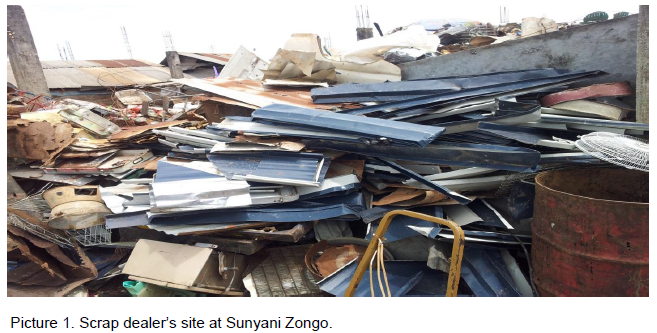
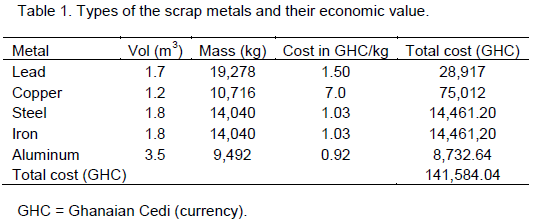
Figure 1 reflects the relative abundance of the various types of scraps in terms of volume. This is important because metals are incompressible and therefore only certain volume and weight could be taken at any given time by the scrap transports. This has implication for profit margins. In terms of the available volume, aluminum is the leading scrap metal taking up to 35% of volume while copper has the least percentage of the volume. Thus aluminum is by far the most common metal in the municipality. This may be due to the fact that aluminum is processed in Ghana, and therefore is abundant in the country (Husband et al., 2009). Most of the aluminum scraps were obtained from cans which are obtained from various drinks manufacturers. The relatively few presence of the other metals is an indication of relatively weak industrialization status of the municipality and the country. Aluminum production from the raw sources is highly energy dependent and Ghana uses much of her energy production for harnessing aluminum (Husband et al., 2009), therefore reuse and recycling of aluminum is going to save Ghana energy as well as virgin resources. Thus policy makers and authorities in Ghana should help intensify aluminum reuse and recycling.
Source of collection
Figure 2 shows the sources of these scraps from the municipality according to the information from the interviewees. It indicates that refuse dumps and the households are the highest producers of scraps (77%). The fact that the dump site leads as the source of scrap (39%) shows that a lot of people in the municipality do not know or understand the value of scrap as source of income as well as its role in a circular economic model. This shows that there is the need for more public education and sensitization of circular system, especially regarding the value of scrap metals in the municipality. Understanding the value of the scrap will reduce the amount of scrap waste that goes to the dumping site (European Commission, 2014). The measure will also facilitate resource recovery and reduce waste disposal at the dumping site (Broadbent, 2015; Accenture, 2014).
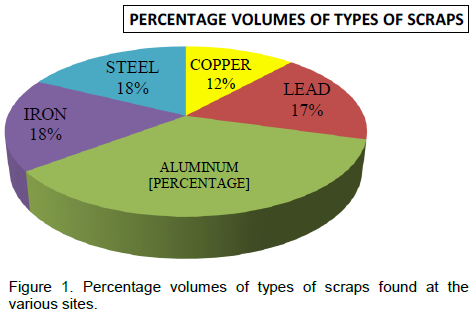
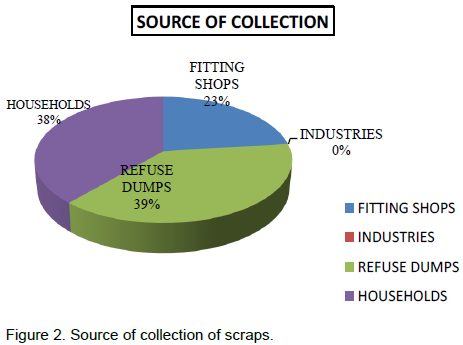
Time for purchasing the scrap by dealers
Figure 3 shows that the scraps are mostly purchased by trade dealers on monthly basis from the scrap owners in the municipality. The data shows that the monthly purchase is the most prevalent occurrence. The implication for this is that scrap owners in the municipality will have to wait for a month before they could earn income. This is a challenge for people whose livelihood depends on scrap metal in less developed countries with low level of industrialization. Therefore scrap metal business should be linked to other alternative circular models for it to be more patronizing and sustainable.
Location of buyers
Scraps transported monthly are mostly delivered to buyers (wholesalers) in Tema which is the official industrial city in the country. This is followed by purchases in Accra where 25% of the volume is delivered for sale (Figure 4). The distance between Sunyani and Tema or Accra is quite far, and this will have implication on costs and profit margins for both the buyers and sellers of the scrap metals. In the context of circular economic models, governments and manufacturers should set up scrap metal foundries at strategic locations closer to the sources of scraps so as to reduce
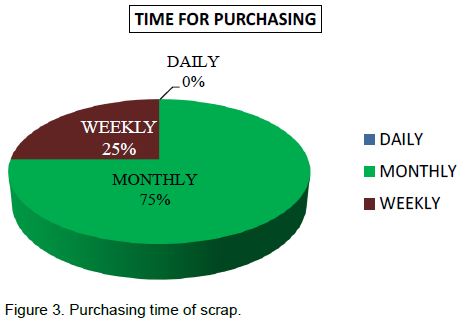
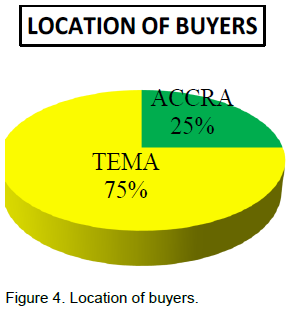
transportation time and costs. Picture 2 shows a truck loaded with the scraps for delivery to buyers at the designated points.
Cost per kilogram that dealers in scraps buy from collectors
From Figure 5, copper is most costly (61%), GH¢7/kg followed by lead which is 13% (GH¢1.50/kg). This may explain why copper is the most sought after metal in Ghana by thieves.
Selling price per kilogram of scraps from dealers to metal works companies
The selling price in Figure 6 follows the same trend as the cost prices in Figure 5. Here again, copper is the most attractive in selling price, followed by lead.
Profits made by dealers per month (%)
From the profit per month information above in Figure 7, it is rather the aluminum and iron that attract the highest profit of 28% each, followed by lead and steel of 19% each. This implies that the greater the volume of sale of particular metal, the higher the turn over and, for that, the profit. Thus, even though, copper attracts higher selling price per kg, its overall profit margin to the dealer is relatively small due to small volume of copper available for sale. This means that tax incentives should consider scrap quantity and quality as this has effect on profitability.
Conclusions drawn from this study are that scrap business which is growing in strength in Sunyani, and in many cities in Ghana, should be worked out into circular manufacturing economy to create jobs as well as reduce use of virgin materials and energy. The importance of the scrap business has induced scrap dealers to travel far to purchase and sell afar from the areas of generation. However, the concept and growth of the business can be sustained and or increased if the public are educated and sensitized about the need to integrate scrap metal management into the bigger picture of circular economy of Ghana. Also, scrap owners who sell to dealers outside the municipality should be educated about the efficiency of their business as well as how to diversify and manage their incomes, since sales are done mainly on monthly basis.
It is inferred from the findings that the main constraints that could affect scrap business in Sunyani municipality and Ghana at large are: the relatively long haulage distance; the low level of industrialization and lack of public awareness about the resourcefulness of the scrap metals. The latter challenge could be overcome by the right educational and sensitization campaigns. The long haulage distance by the dealers could be reduced by siting appropriate scrap transfer, recycling and foundry stations along major haulage routes.
From the foregoing analysis and conclusions, it is recommended that the Sunyani Municipality and the government of Ghana should provide policy, educational and sensitization mechanisms to the public about the value and opportunities of scrap metals as business entity and job creation. Besides, the public and communities should understand the need for resource recovery and waste management improvement as well as environmental pollution prevention
The study was supported by the writers’ own funds and therefore does not pose any conflict of interest to any entity or organization. The terms of this arrangement have been reviewed and approved by the University of Energy and Natural Resources, Sunyani, Ghana in accordance with its policy on objectivity in research.
This study was made possible through the help and support from its contributors, family and friends. Especially, please allow me to dedicate my acknowledgment of gratitude to the following significant advisors and contributors: First and foremost, I would like to thank Dr. Francis Attiogbe for his significant contribution. He helped with the statistical analysis and offered financial support for the publication of the paper. Second, I would like to thank Mr. Engelbert Kumi for the field data collection and analysis; finally, I sincerely thank the authorities of the University of Energy and Natural Resources, Sunyani, for their encouragement to publish quality papers.
REFERENCES
|
Accenture (2014). Circular Advantage: Innovative Business Models and Technologies to Create Value without Limits to Growth. Accenture Strategy Document, pp. 24.
|
|
|
|
Amponsah M (2011). Dynamics of Land use planning and its effects on socio-economic development. Case study of Sunyani Municipality and Odumasi in the Brong Ahafo Region. MSc Thesis, College of Architecture and Planning, Kwame Nkrumah University of Science and Technology, Kumasi, Ghana.
|
|
|
|
Andrews CJ (2013). "Empowering Sustainable Consumption [Policy Perspectives]." IEEE Technol. Soc. Mag. 32(3): 8-9.
Crossref |
|
|
|
|
Bechtel N, Bojko R, Völkel R (2013). Be in the loop: Circular Economy and Strategic Sustainable Development. MSc Thesis, School of Engineering, Karlskrona, Sweden.
|
|
|
|
|
European Commission (2014).Towards a circular economy: A zero waste programme for Europe, COM (2014) 398 final.
|
|
|
|
|
Husband C, McMahon G, Van der Veen G (2009). The Aluminum industry in West and Central Africa: Lessons learned and prospects for the future. Extractive industry and development series no. 13. World Bank 1 oil, gas and mining division working paper.
|
|
|
|
Jeswiet J, Hauschild M (2005). "EcoDesign and future environmental impacts." Mater. Design 26(7):629-634.
Crossref |
|
|
|
Meier H, Roy R, Seliger G (2010). "Industrial Product-Service Systems - IPS²." CIRP Annals Manufacturing Technology 59(2):607-627.
Crossref |
|
|
|
|
Waughray D (2014). Towards the Circular Economy: Accelerating the scale-up across global supply chains. World Economic Forum, Geneva in collaboration with Ellen MacArthur Foundation and Mckinsey and Company.
|
|